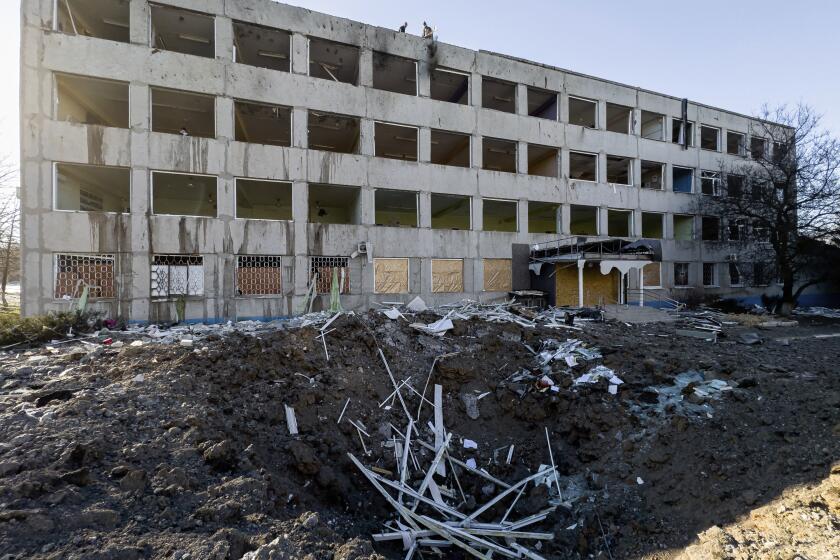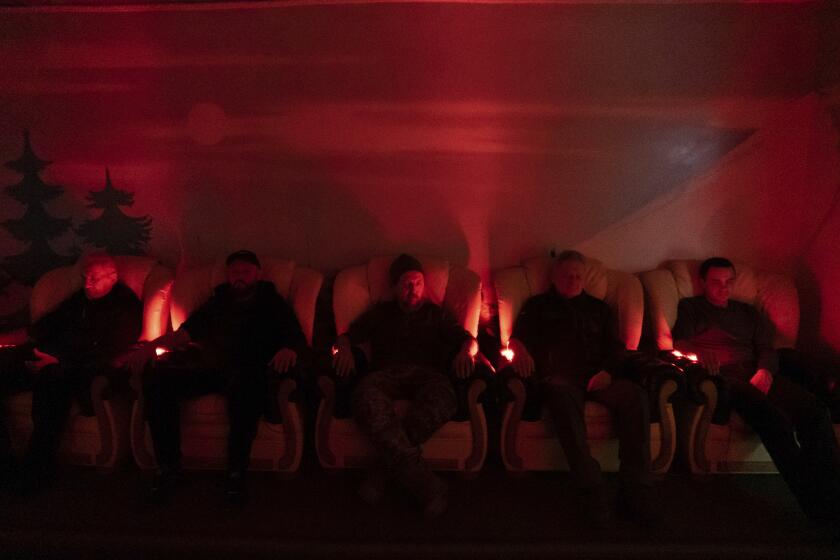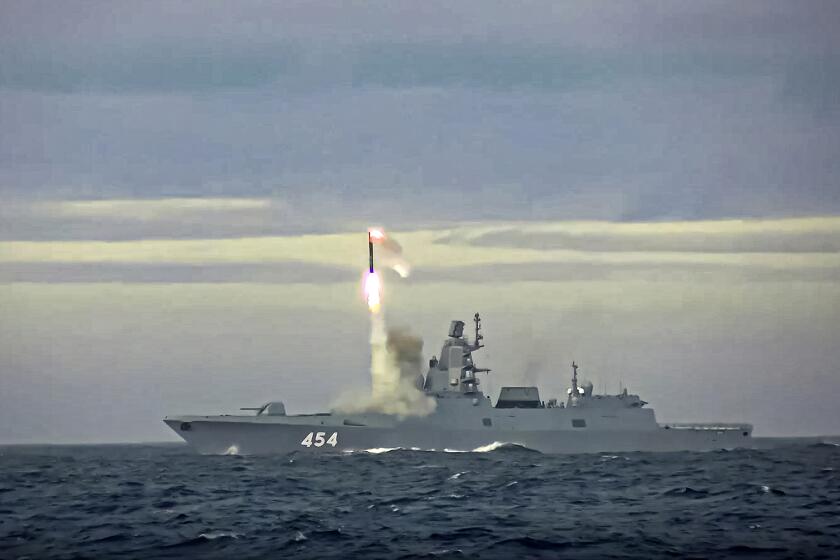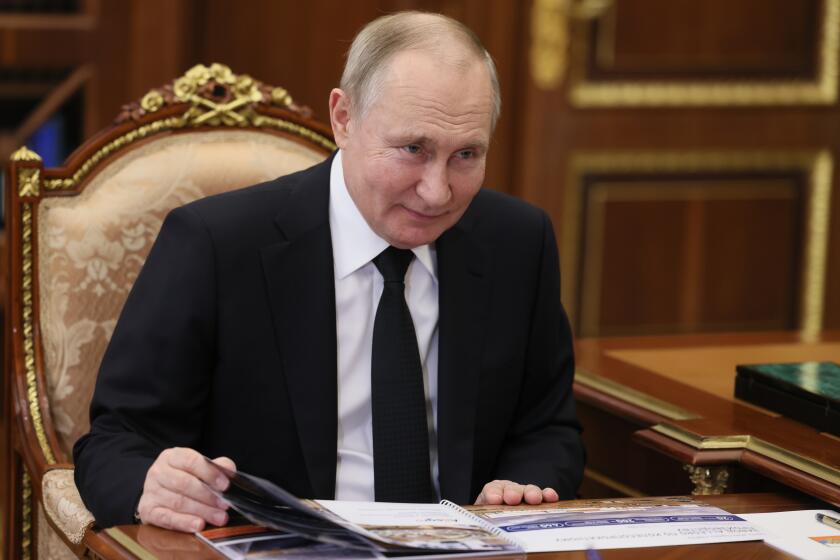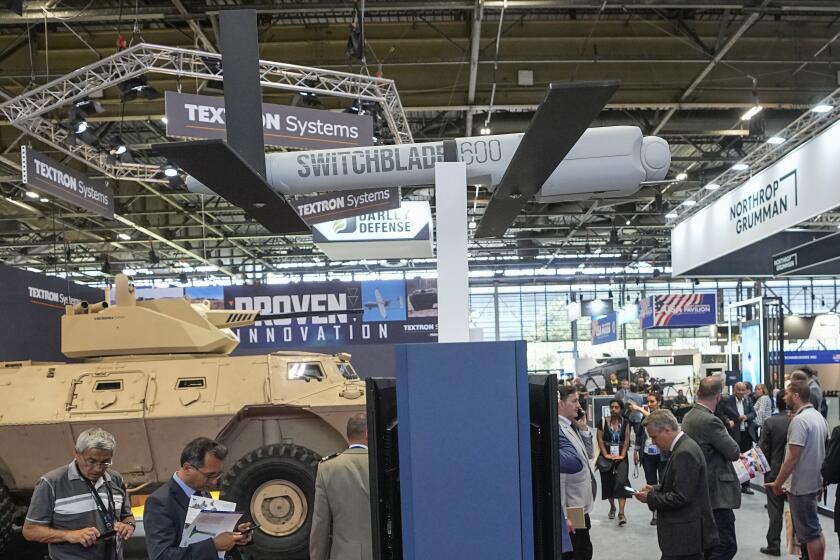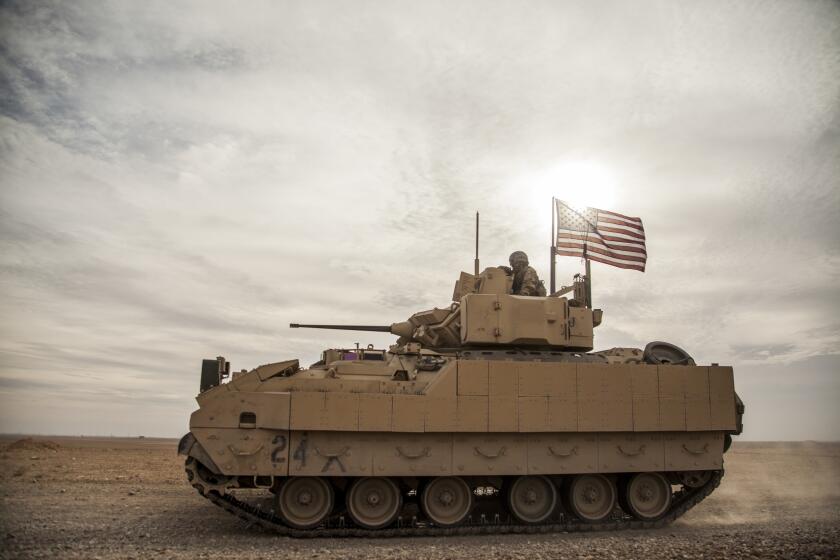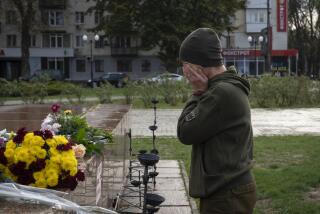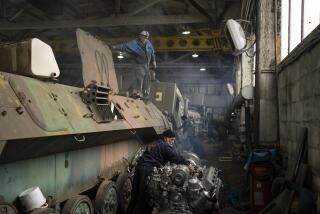‘What madness looks like’: Russia intensifies attack on Bakhmut in eastern Ukraine
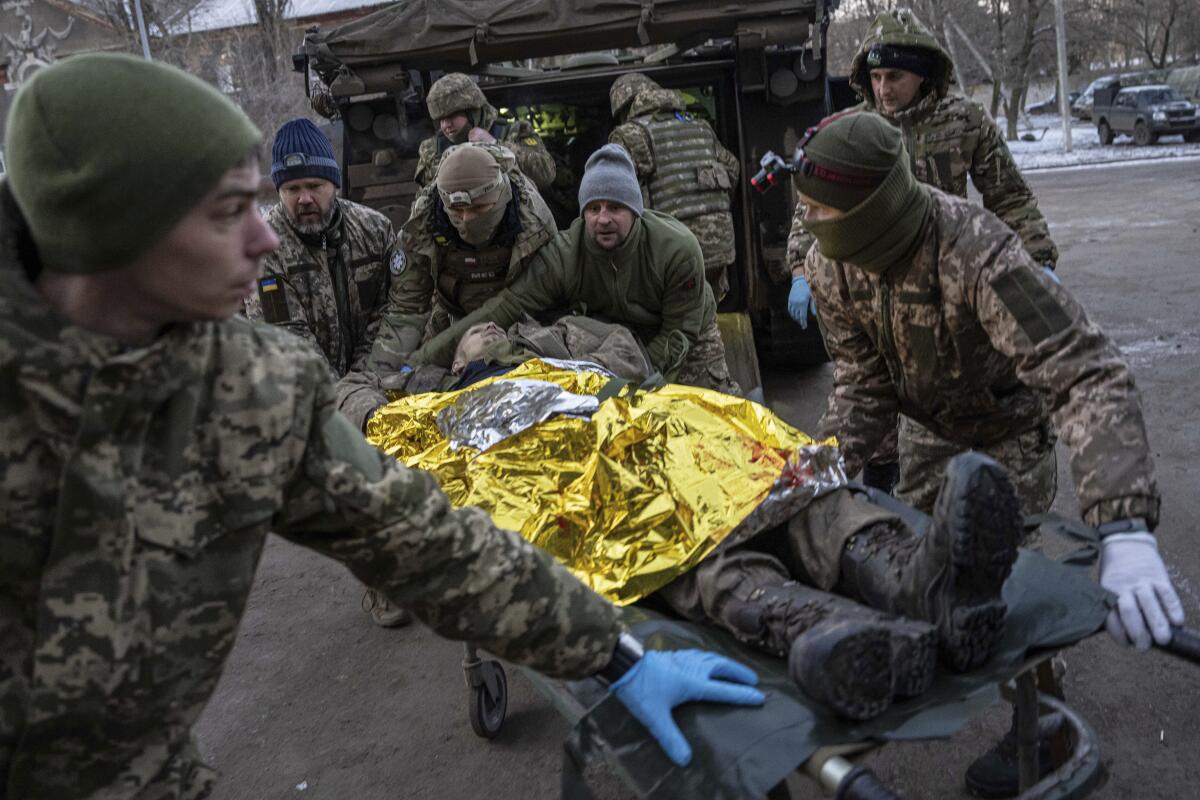
- Share via
KYIV, Ukraine — Russian forces are escalating their onslaught against Ukrainian positions around the wrecked city of Bakhmut, Ukrainian officials said, bringing new levels of death and devastation in the grinding, months-long battle for control of eastern Ukraine that is part of Moscow’s wider war.
“Everything is completely destroyed. There is almost no life left,” Ukrainian President Volodymyr Zelensky said late Monday of the scene around Bakhmut and the nearby city of Soledar in Donetsk province.
“The whole land near Soledar is covered with the corpses of the occupiers and scars from the strikes,” Zelensky said. “This is what madness looks like.”
Russia, whose invasion of its neighbor 10½ months ago has suffered numerous reversals, is hungry for any victories. The Kremlin illegally annexed Donetsk and three other Ukrainian provinces in September, but its troops have struggled to advance or establish complete control over those areas.
After Ukrainian forces recaptured the southern city of Kherson in November, the battle heated up around Bakhmut.
Ukraine’s deputy defense minister, Hanna Malyar, said Russia had thrown “a large number of storm groups” into the fight for the city. “The enemy is advancing literally on the bodies of their own soldiers and is massively using artillery, rocket launchers and mortars, hitting their own troops,” she said.
Officials at a school in eastern Ukraine say a Russian rocket merely blew out windows and damaged classrooms, with no troops or bloodshed anywhere.
Pavlo Kyrylenko, the Donetsk region’s Kyiv-appointed governor, on Tuesday described the Russian attacks on Soledar and Bakhmut as relentless.
“The Russian army is reducing Ukrainian cities to rubble using all kinds of weapons in their scorched-earth tactics,” Kyrylenko said in televised remarks. “Russia is waging a war without rules, resulting in civilian deaths and suffering.”
Wounded soldiers arrive around the clock for emergency treatment at a Ukrainian medical stabilization center located near the front line around Bakhmut. Medics at the center for combat casualties fought for 30 minutes Monday to save a soldier, but his injuries were too severe.
Another soldier had a head injury after a fragment pierced his helmet. Medics quickly got his condition stable enough to transfer him to a military hospital for further treatment.
An old Ukrainian sanatorium has been converted into a recovery center where service members can get treatment for both mental and physical ailments.
“We fight to the end to save a life,” Kostnyantyn Vasylkevich, a surgeon and the center’s coordinator, said. “Of course, it hurts when it is not possible to save them.”
The Moscow-backed leader of the occupied areas of Donetsk said Tuesday that Russia’s forces were “very close” to taking over Soledar. But the gains were coming “at a very high price,” Denis Pushilin told Russian state TV.
Control over the city would create “good prospects” for taking over Bakhmut, Pushilin said, as well as for a further assault on Siversk, a town further north where Ukrainian fortifications “are also quite serious.”
The British Defense Ministry concurred with that appraisal of the battle developments. Russian troops alongside soldiers from the Wagner Group, a Russian private military contractor, have advanced in recent days in Soledar and “are likely in control of most of the settlement,” the ministry tweeted Tuesday.
Start your day right
Sign up for Essential California for the L.A. Times biggest news, features and recommendations in your inbox six days a week.
You may occasionally receive promotional content from the Los Angeles Times.
It said that taking Soledar, which is six miles north of Bakhmut, was likely Moscow’s immediate military objective and part of a strategy to encircle Bakhmut.
But it added that “Ukrainian forces maintain stable defensive lines in depth and control over supply routes” in the area.
The Wagner Group’s leader, Dmitry Prigozhin, confirmed in a post on a Russian social media platform Tuesday that his forces were fighting in the area and acknowledged “heavy battles” in Soledar against a Ukrainian army he said “bravely fights.”
A Western official, speaking on condition of anonymity, said the Wagner Group “has moved from being a niche sideshow of Russia’s war to a major component of the conflict,” adding that its forces now make up as much as a quarter of Russian combatants.
Russia has sent a frigate armed with the country’s latest hypersonic weapons on a transoceanic cruise in a show of force amid tensions with the West.
An exceptional feature of the fighting near Bakhmut is that some of it has taken place around entrances to disused salt mine tunnels that run for about 120 miles beneath the area, the British intelligence report noted.
“Both sides are likely concerned that [the tunnels] could be used for infiltration behind their lines,” it said.
In Russia, two signs emerged Tuesday that officials were grappling with the military shortcomings revealed during the conflict in Ukraine.
Russian Defense Minister Sergei Shoigu, whose performance has been fiercely criticized in some Russian circles but who has retained Russian President Vladimir Putin’s confidence, said Tuesday that his military would use its experience in Ukraine to improve combat training.
President Vladimir Putin claims that Russia’s nuclear arsenal is ‘more advanced’ than that of any other nation.
Military communications and control systems will be improved using artificial intelligence, Shoigu said, and troops will be given better tactical gear and equipment.
The second indication of trouble involves Russia’s production of weapons and other supplies its military needs for the fight in Ukraine. The deputy head of Russia’s Security Council, Dmitry Medvedev, warned that officials who failed to meet deadlines for such items could face criminal charges.
Putin appointed Medvedev last month to head a new commission tasked with trying to solve the military’s supply problems. Numerous reports have suggested that Russia is running low on certain weapons and was sending some troops into battle with insufficient equipment and clothing.
Part of the Kremlin’s challenge is keeping up with the weapons and supplies that Western allies have provided to Ukraine. Kremlin spokesman Dmitry Peskov said Tuesday that NATO members “have become a party to the conflict, pumping weapons, technology and intelligence data into Ukraine.”
The longer Russia’s invasion of Ukraine lasts, the more likely that drones will be used to identify and attack targets without human aid, experts say.
Several front-line cities in eastern Ukraine’s Donetsk and Luhansk provinces have witnessed intense fighting in recent months.
Together, the provinces make up the Donbas, a broad industrial region bordering Russia that Putin identified as a focus from the war’s outset and where Moscow-backed separatists have fought since 2014.
Russia’s grinding eastern offensive captured almost all of Luhansk during the summer. Donetsk escaped the same fate, and the Russian military subsequently poured manpower and resources into the area around Bakhmut.
Taking Bakhmut would disrupt Ukraine’s supply lines and open a route for Russian forces to press on toward Kramatorsk and Sloviansk, key Ukrainian strongholds in Donetsk.
Armored vehicles from the U.S. and Germany, including 50 tank-killing Bradleys, should expand Ukraine’s ability to move troops to the front lines.
Like Mariupol in the south and other contested cities, Bakhmut has endured a long siege, spending weeks without water and power even before Moscow launched massive strikes to take out public utilities across Ukraine.
Kyrylenko, the Donetsk region’s governor, estimated more than two months ago that 90% of Bakhmut’s prewar population of over 70,000 had fled since Moscow focused on seizing the entire Donbas.
Zelensky’s office said at least four civilians were killed and another 30 wounded in Russian shelling between Monday and Tuesday.
Vitaliy Kim, the governor of the southern Mykolaiv region, said Russian forces shelled the port of Ochakiv and the area around it late Monday and then again early Tuesday. He said 15 people, including a 2-year-old, were wounded in Monday’s shelling.
More to Read
Sign up for Essential California
The most important California stories and recommendations in your inbox every morning.
You may occasionally receive promotional content from the Los Angeles Times.
